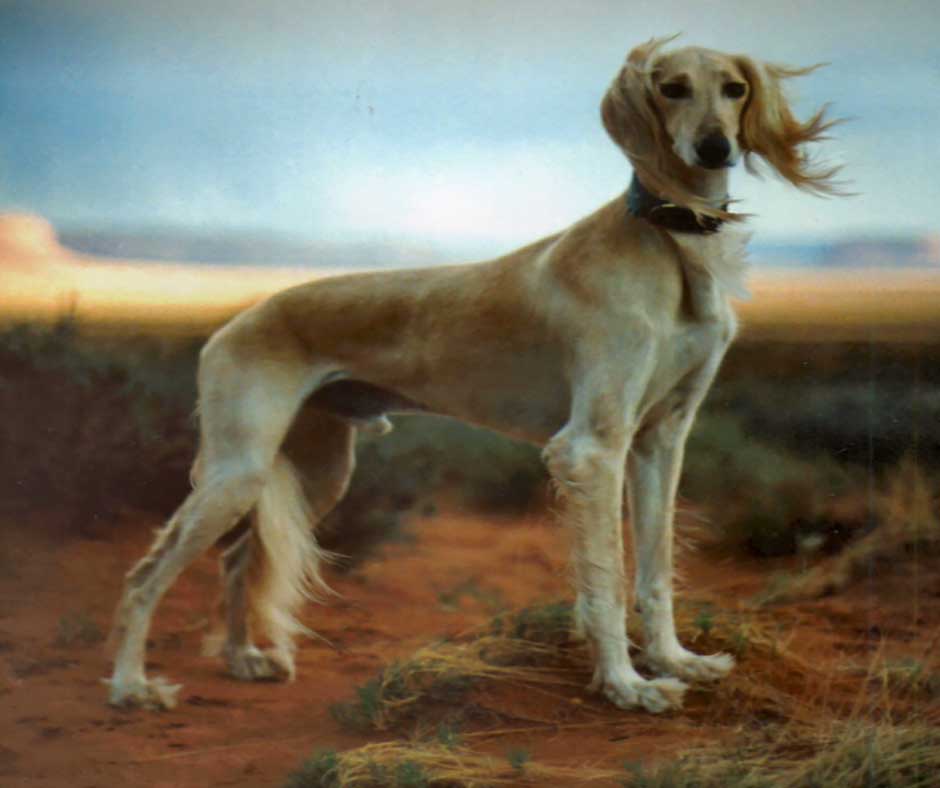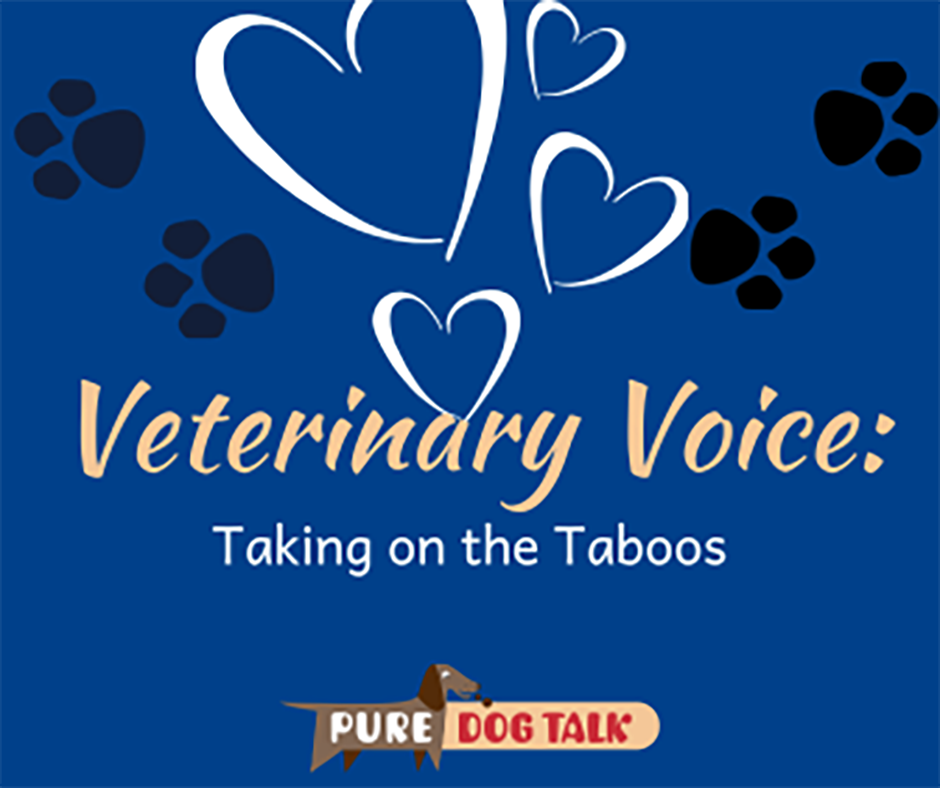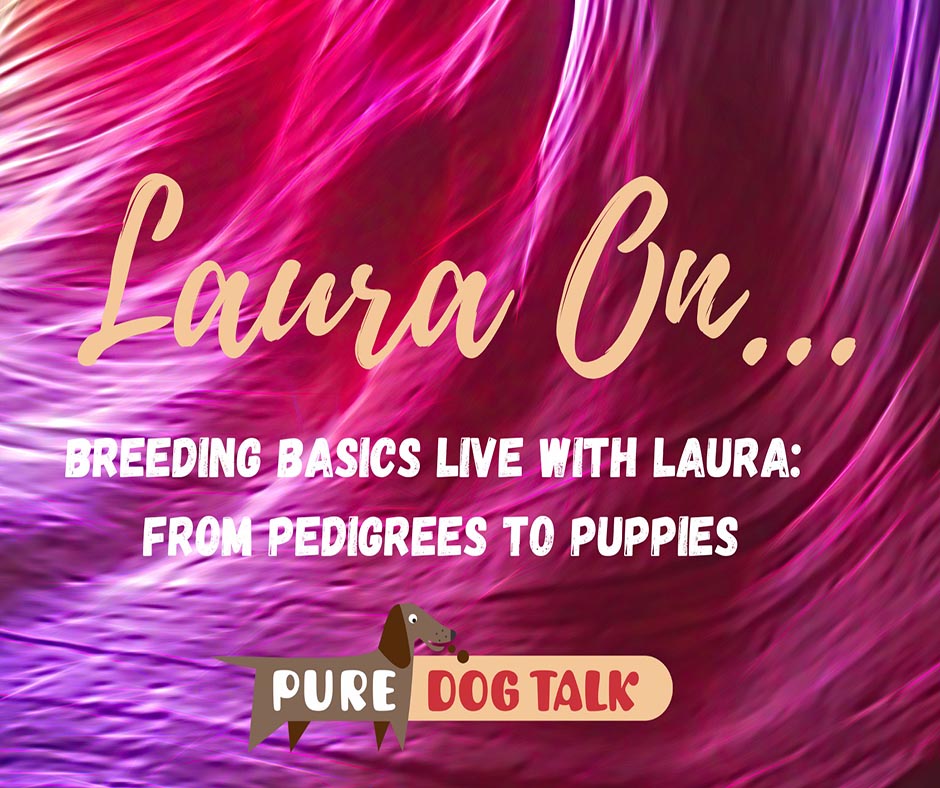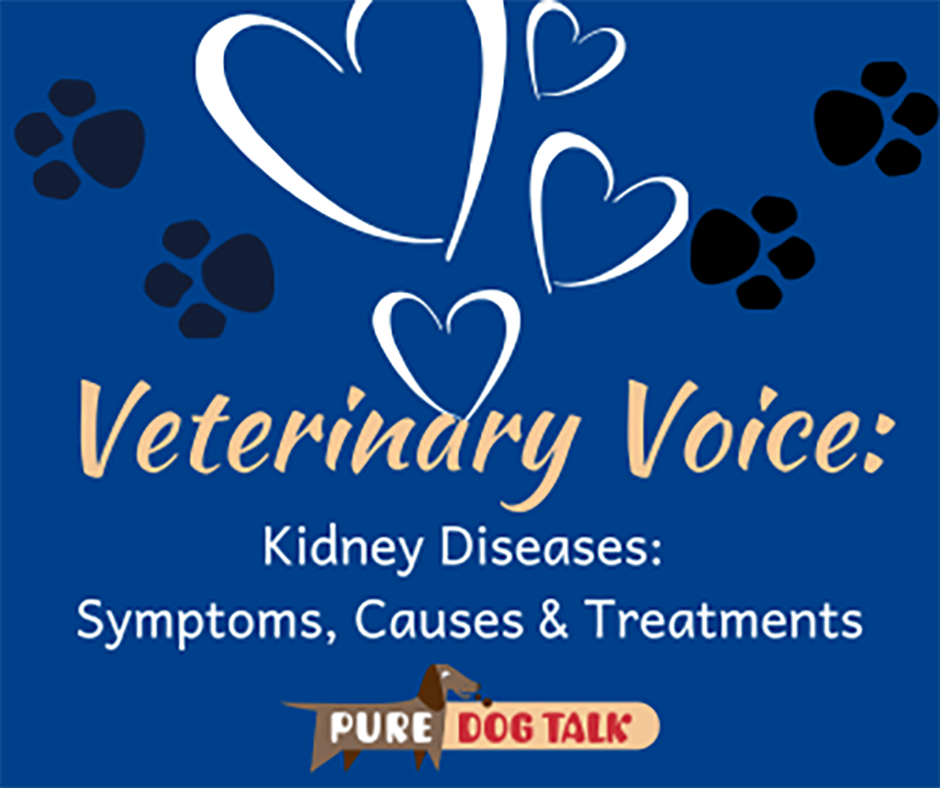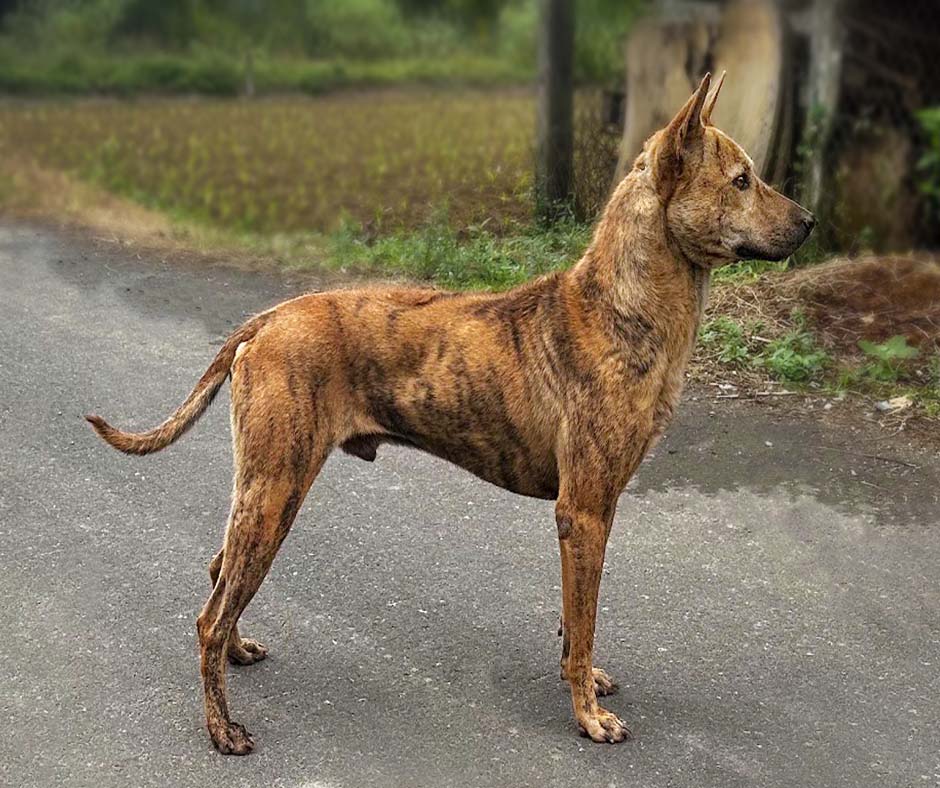596 – Black and Tan Coonhounds with Kathy Corbett
Black and Tan Coonhounds with Kathy Corbett

Kathy and Boomer, Ch. WyEast Why Not.
Pure Dog Talk’s Love the Breed series, focused on hound breeds, continues today with 50 years of knowledge about Black and Tan Coonhounds as breeder Kathy Corbett joins host Laura Reeves for this insightful conversation.
Kathy and Jim Corbett acquired their first Black and Tan Coonhound sight unseen in 1971. They wanted a short coated dog of a size that was easy to reach for a pat on the head and was good with the family. The WyEast Black and Tan Coonhounds are legend, including Boomer, Am/Can/UKC Ch. WyEast Why Not.
Am/Can Ch. WyEast Why Not was the all time top winning Black and Tan Coonhound in the history of the breed with a show record which includes 12 All-Breed Best in Shows, 64 Hound Group wins, and 201 Hound Group Placements. A grandson of National Specialty and Hound Group winning Ch. WyEast Wanderlust, Boomer was number one Black and Tan Coonhound in total dogs defeated for five successive years – 1987, 1988, 1989, 1990, and 1991. He was also awarded Best of Breed at the National Specialty of the American Black and Tan Coonhound Club for the years 1990 and 1991.
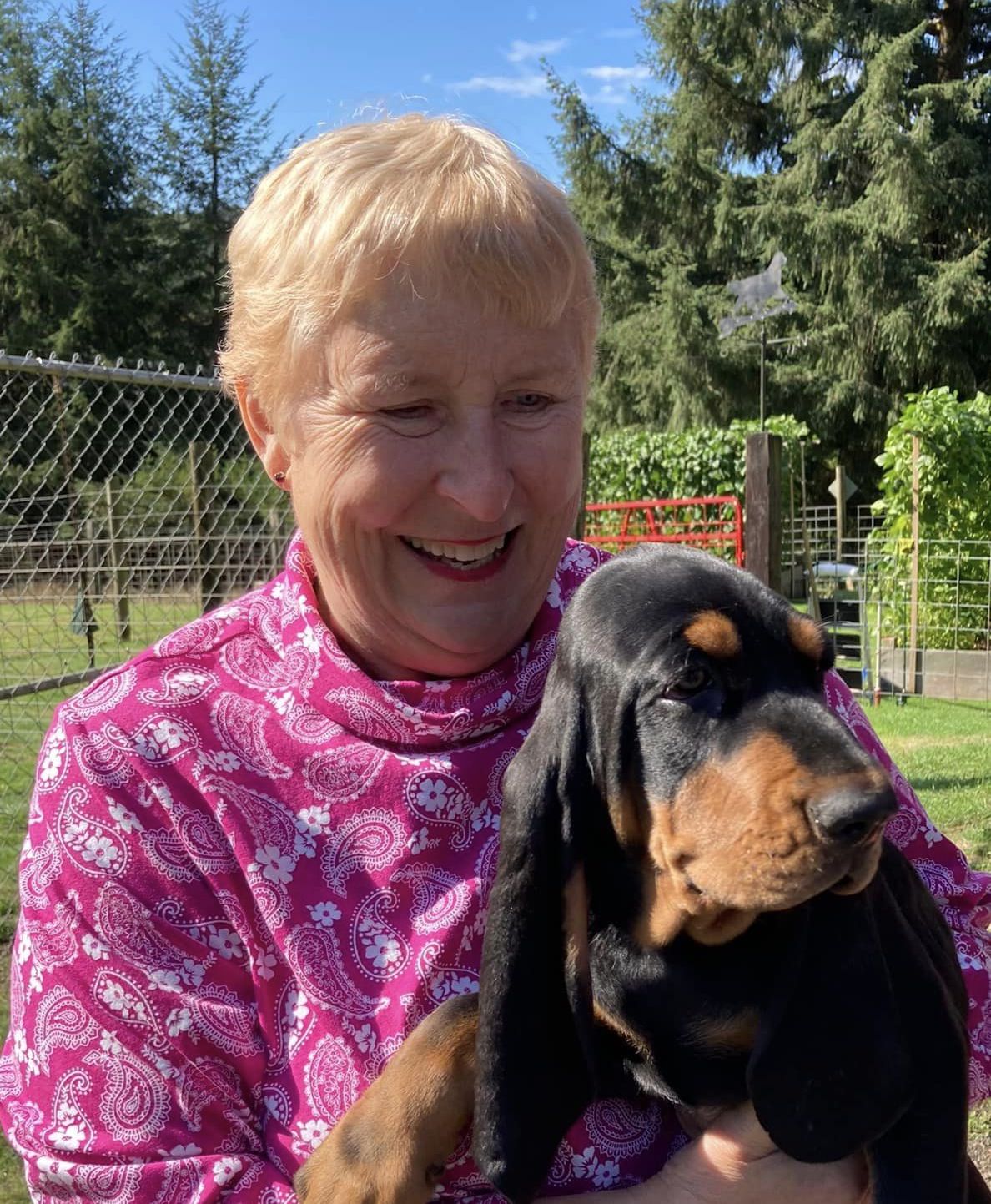
Kathy and a typical Black and Tan Coonhound puppy.
“(Black and Tan Coonhounds) have a kind of a muddled history,” Corbett said. “We certainly go back to foxhounds. George Washington had fox hounds and he had dogs that happened to be black and tan in color. It was quite a while before the utilitarian dogs that would hunt for anything with fur that could run were divided essentially by coat color and a little bit by their style of hunting.
“Five of the coonhound breeds generally were used to track and trail coons and other animals that would either go to ground or tree. The Plot hound is much more aggressive and was used primarily for bear because it takes a tough dog to take on a bear.
“But in general, these were dogs that would chase anything with fur that would run and they were the dogs that put meat on the table. Some of the breeds, like Treeing Walkers, were a little faster. Black and Tans were the ones that weren’t necessarily as fast, but would stay on a trail forever and had great endurance. And they’re also wonderful dogs to have around. They were very reliable with other dogs and children.
“We loved their temperament. We wanted a dog that would run all night if we wanted it to, or go hiking or camping or anything that the family wanted to do and then would come in the house and lie down and go to sleep. And that’s exactly what we found.
“When we place a puppy, we do try to impress upon the people that this is an on-leash breed. They are bred to hunt independently. They are bred to take off on their own. And they will. And it’s your job to find them, to follow them. Their end of the bargain is that when they get something up a tree that they will yell their heads off so you can find them. But if that doesn’t happen, for instance if they’re after a deer, they usually just go and go and go.
“So in general for hiking or anything else, they are on lead dogs and at home they need a fence. They’ll range for 10 miles. If they remember where they came from, they’ll come back. But they go, and it’s not a matter of training. You’re working against hundreds of years of instinct.”
595 – Love the Breeds: Salukis with Caroline Coile
Love the Breeds: Salukis with Caroline Coile
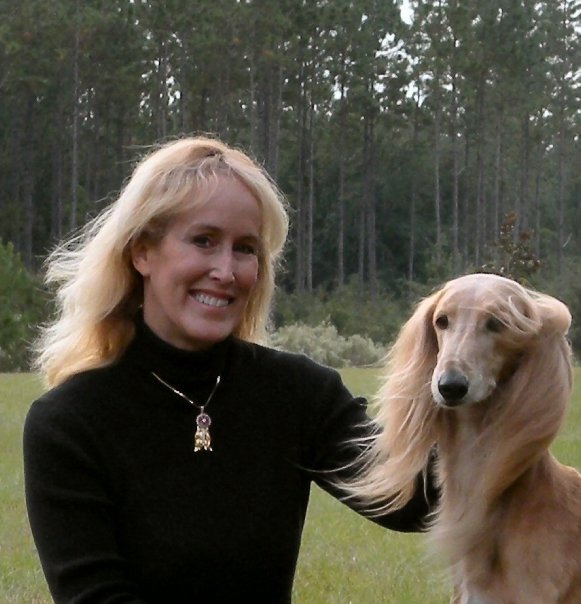
Caroline Coile with her Saluki, Prophet.
Author and Saluki breeder Caroline Coile joins host Laura Reeves for the kick-off of our Love the Breeds feature.
Some of Coile’s tongue-in-cheek descriptions of the ancient breed include “breathing furniture,” “arm candy” and “they don’t like to show their feelings.”
“We have a lot of artwork that does indicate that there were saluki-like dogs … all over the Middle East,” Coile said. “But not just the Middle East, but everywhere the Silk Road went. We see them in China and obviously, it’s pretty easy to take this dog and bring it with you to trade or hunt or whatever.
“We know that some of the first Salukis that came to the western part of the world, to England, were there by the 1700s because there was a famous painting of Zilla … she was, if we can judge from this painting, a gorgeous black and tan, very refined, long feathering… she would have won in the show ring today.
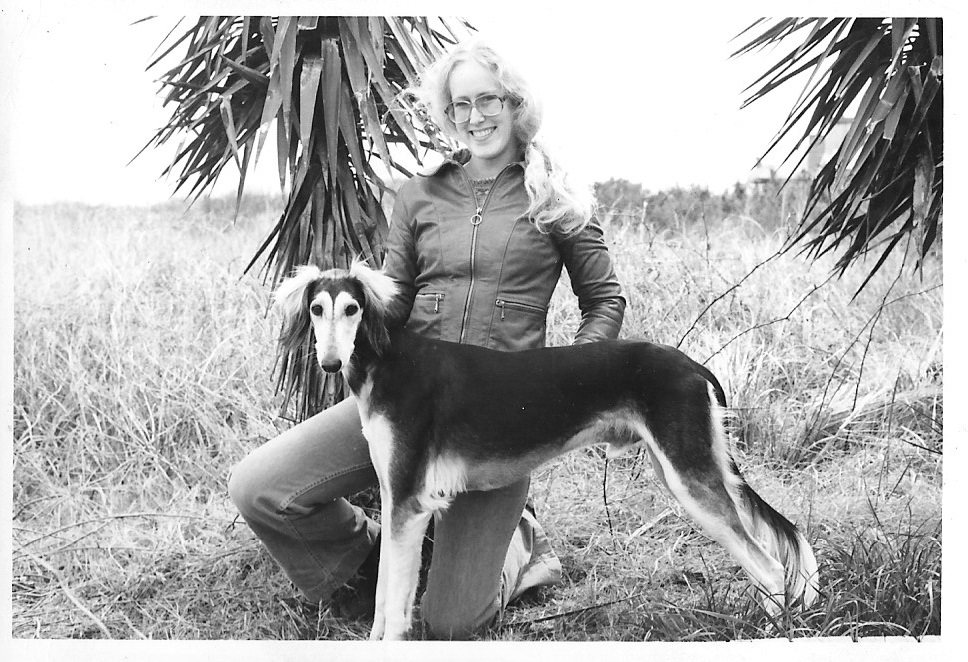
Baha, Ch Srinagar Bhavant Bhairava CD LCM, Coile’s first saluki, in 1975.
“I think that there were two different families (of Salukis), those that went with the Bedouin and they probably hunted hare and rabbit and helped fill their pot with that whatever they could catch. And then I think there were some that the royalty took out on the giant Gazelle Hunts, which would have been a great King Tut and all that sort of thing. A great sport, but probably not a cost efficient one in terms of, you know, calories per what you can bring back.
“An advantage to the Saluki is how peaceful they are. When they’re not going, they’re peaceful and they’re not fighting with each other. They’re not fighters. They get along. This is the norm. They like to sleep in your bed. They won’t stay off your furniture. They are climbers. I have one that can get on the refrigerator. Oh well, she doesn’t just jump up from the floor, she gets on the counter beforehand and won’t stay off that though so I put stuff on the refrigerator to keep it away from her.
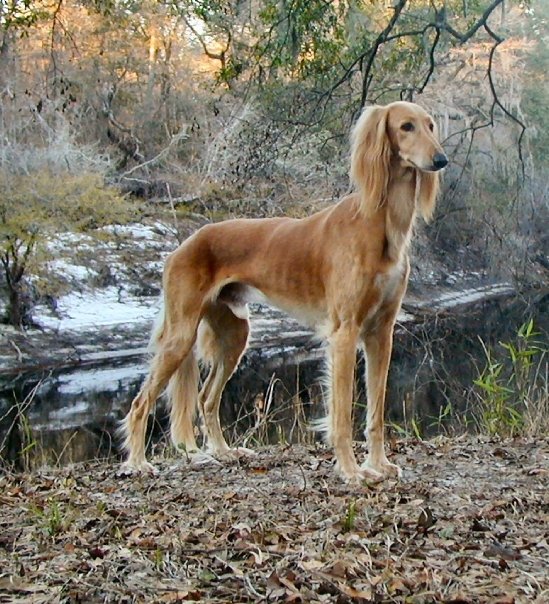
BIS BIF HIT GCh Khiva’s Prophet of Baha, CD, FCh, SC, RA, JOR
“I know one of the things that I think is really important to get across to folks that want to live with what I sort of jokingly, to my friends, refer to as dog arm candy. They’re really beautiful. (But) the important part to remember is they’re dogs and their long developed natural instincts are to chase and kill things and do that very independently.
“The whole motto is that saying ‘if looks could kill’ … you look at their breed standard and that basically defines the saluki breed standard in four words. I get a lot of inquiries from new pet owners saying, ‘We’re marathon runners and we heard that Salukis are long distance runners.’ And I have to say, ‘Yeah, they’re long distance sprinters, if that makes any sense? They can run at full double suspension gallop longer than any other breed, but I guarantee you that if you try to trot with it for any length of time, it’s like dragging an anchor behind you. They’re not into that. They like to go full speed.
“And then the other thing I would say is that I don’t know about other breeds, but Salukis are the biggest complainers of the dog world. Oh, it’s too hot. It’s too cold. Because they act like they’re royalty.”
594 – Temperament Testing for Better Puppy Placements
Temperament Testing for Better Puppy Placements

Hannah Crane, National Puppy Program Manager for Dogs for Better Lives.
Hannah Crane, National Puppy Program Manager for Dogs for Better Lives, joins host Laura Reeves to take a deep dive on temperament testing for better puppy placements for all breeders. While Crane uses the system to test puppies going in to service work for her organization and others, she discusses why all breeders can follow the protocol to help make the best possible matches for puppies and buyers.
“Temperament tests are exactly how they sound,” Crane said. “They help us to assess and identify any temperaments that the puppies are showing us in a litter. Are we looking at a puppy who is confident and calm in any environment? Are we looking at a puppy who is maybe shy or reserved, unsure of their surroundings? It really helps give us a snapshot in time, what that litter is showing as well as the individual puppies.
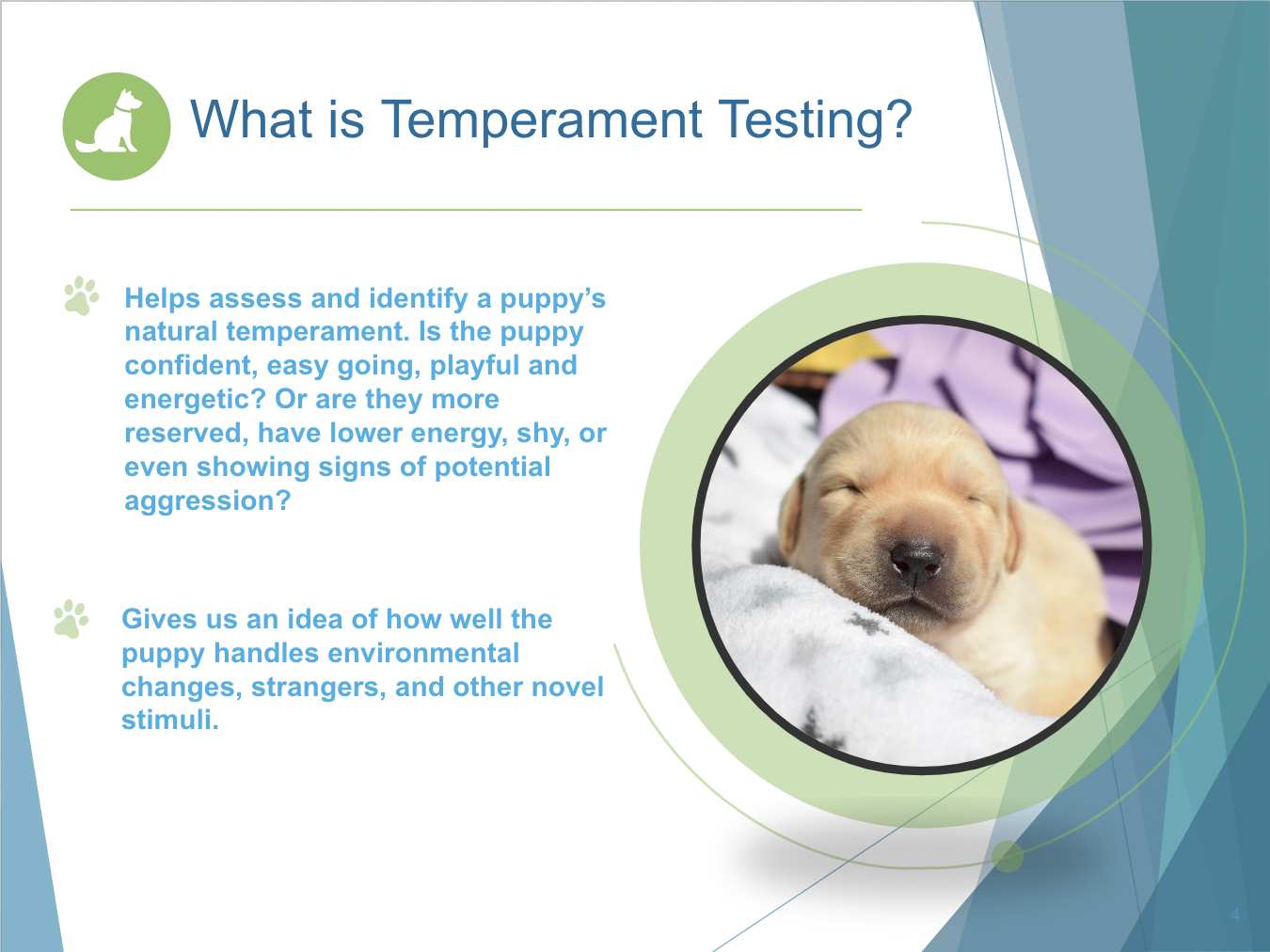 “We get to look at each puppy and the litter as a whole because that’s great data for our breeders. We can see what’s trending. The particular test that we use helps us to see how the puppy reacts to different environments and how it reacts to different people, different stimuli, novel objects and also different stressors.
“We get to look at each puppy and the litter as a whole because that’s great data for our breeders. We can see what’s trending. The particular test that we use helps us to see how the puppy reacts to different environments and how it reacts to different people, different stimuli, novel objects and also different stressors.
“Typically, you wanna do them between seven and eight weeks old. That’s really the prime time to do it. If you’re being really picky, 7 1/2 weeks old is prime. You’re right at their sponge stage. They’re really coming into their own behaviors in the litter, finding their social status as well as right before they go into their first fear period, too. And that’s essential.
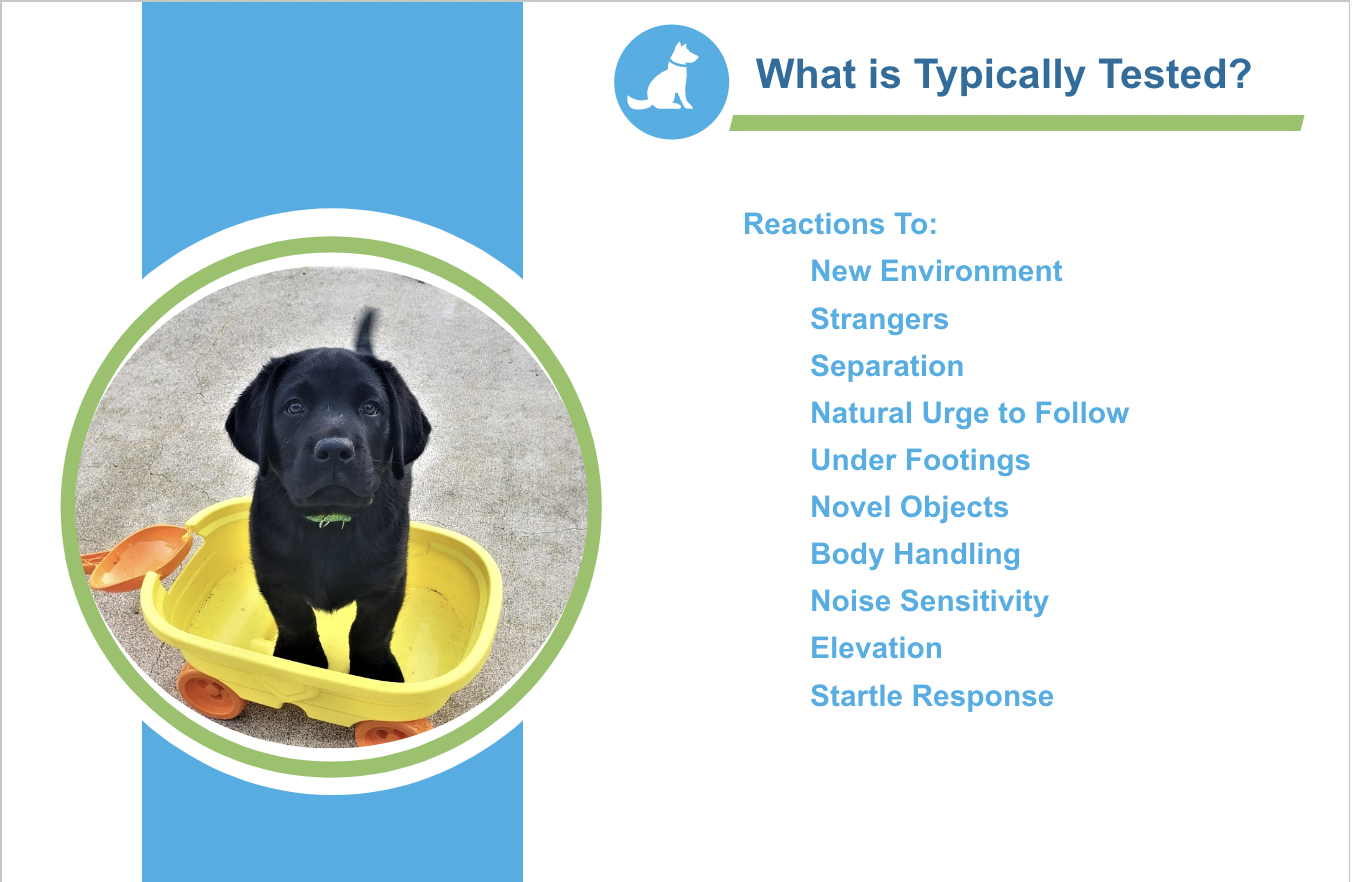 “(Temperament testing is) great for private breeders as well. For you guys to be able to identify which puppies will be successful in a private home or a show dog home or a sport home, I mean our ultimate goal both of us, you know, whether you’re a school or a private breeder, the ultimate goal is to set up these puppies for success, to set up our families and our clients for success. We want that puppy or dog to stay in that home for the rest of its life. This is how we do that.”
“(Temperament testing is) great for private breeders as well. For you guys to be able to identify which puppies will be successful in a private home or a show dog home or a sport home, I mean our ultimate goal both of us, you know, whether you’re a school or a private breeder, the ultimate goal is to set up these puppies for success, to set up our families and our clients for success. We want that puppy or dog to stay in that home for the rest of its life. This is how we do that.”
593 – Taking on the Taboos: Learn the Inside Story of Veterinary Procedures
Taking on the Taboos: Learn the Inside Story of Veterinary Procedures
Dr. Marty Greer, DVM and host Laura Reeves take on the recently taboo subjects of veterinary procedures such as bark softening, tail docking, ear cropping and dewclaw removal. Greer covers the how, when and, importantly, WHY of these procedures.
Debark
Some people call it urban bark. Some people call it bark softening. It kind of gentrifies the term a little bit because you’re really not taking away the bark. You really are softening it. And there’s a lot of misconceptions about it. I’ve heard all kinds of stories about how cruel it is and how difficult the procedure is for the patient. And honestly, none of them are true.
Dewclaws
I don’t see problems with the dewclaws coming off. I know there are people who feel that it weakens the carpal joint in the dog and I, to this day, have not seen a dog breakdown it’s Carpus and have difficulty with its carpal joint related to a declaw removal. We do see dewclaws that get torn off during hunting, during other kind of activities …. I actually haven’t seen any literature that suggests that they’ve got proof that (dewclaw removal) makes a difference.
Tail Dock
Nothing, nothing is more horrible than a broken, bleeding tail. Nothing. They crack them on the wall in the crate, in the kennel. And then they start to bleed. And then, oh my God, it looks like an axe murder happened in your house. It is unbelievable how much blood they can spray around from the end of their tail, and they’re very hard to bandage. They don’t heal very well, so they can be a real challenge.
There’s a lot of reasons that people do tails. It’s not just about breed type, it is really about function as well.
Watch Dr. Greer perform this simple procedure.
Ear Crop
Breed type is a big deal. If you don’t crop the ears on a Doberman, it doesn’t look like a Doberman.
I think we have to be really honest with ourselves that it’s about appearance, it’s about breed type. It’s primarily a cosmetic procedure and we have to be honest about it. But you have to decide what you’re breeding for because again, ear set and ear leather has changed because people don’t really pay attention to it.
In Closing
I will tell you that a lot of the procedures that (some folks) are telling people not to do are far less invasive and far more beneficial for the pet than spaying and neutering. Because why do we spay and neuter our dogs? Because we’re too lazy to control their sexual behavior. It’s not for their health. The American public has become complacent and will not (train) their dogs.
592 – Prevent or Correct Coat Stains in White Dogs
Prevent or Correct Coat Stains in White Dogs
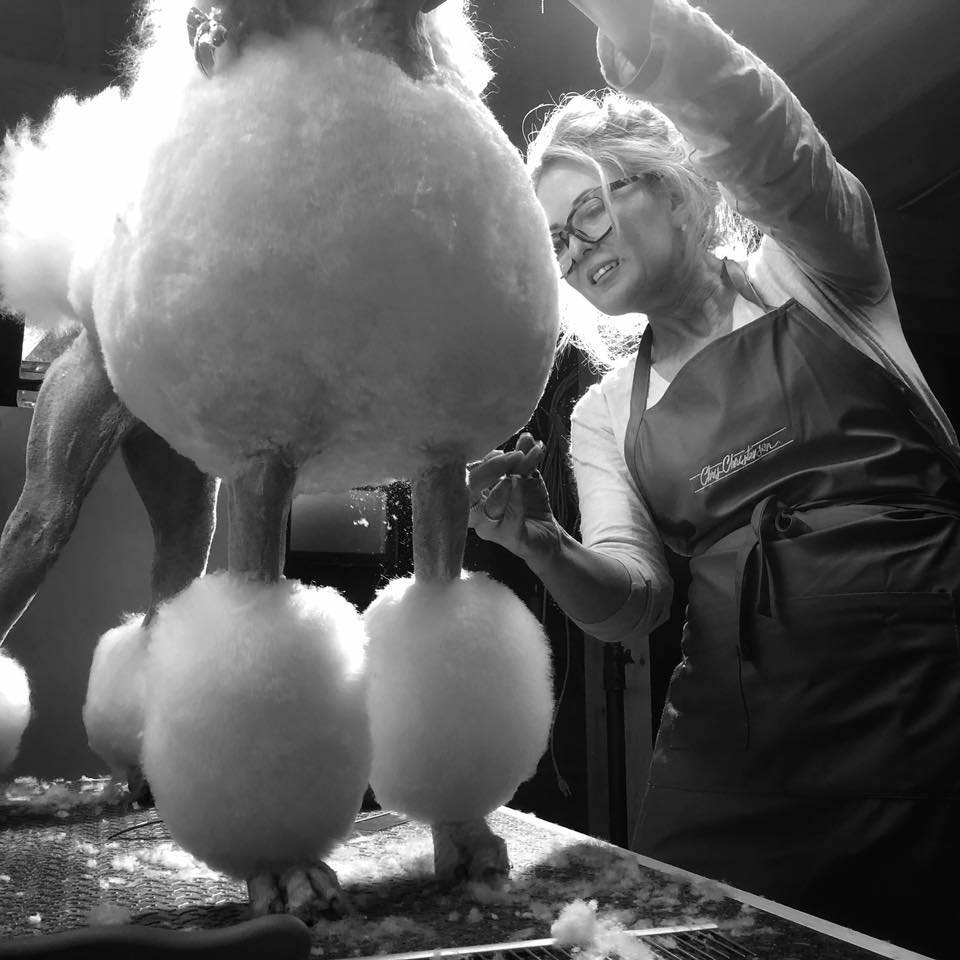
Allison Alexander working with a white poodle.
Allison Alexander returns to the podcast to discuss how to prevent or correct coat stains in white dogs. Allison and host Laura Reeves take a true deep dive into the details, tips, tricks and methods to manage unsightly staining for all coat types.
“One of the things I’ll say about white dogs,” Allison said, “is even if you haven’t prevented it and you need your dog to be whiter, you need to follow some of the prevention protocols in order to keep them white. In my experience, once you start whitening a coat, even with something you might think is gentle, our dogs do tend to restain a little bit quicker.
“Basically there are three of the more popular ways to keep our dogs white once they’re stained. So, they are using a bluing shampoo, something that has some bluing in it. But what that is doing, it’s really just changing the spectrum. They take something yellow, they put a purple filter over it and then our eye sees that as white and so the problem with that is you do that too often and then your eye starts to see the purple or Gray or something in between there.
“And then the other popular one is an enzymatic cleaner. So those are super popular, but what those actually do is the enzyme is actually eating the stain, therefore eating some of the keratin that’s in the hair and then that makes the hair actually quite weak after a while and it can not only go dingy, turn different color, (it) can actually snap off. So that’s kind of scary.
“Same with bleach. Bleach is doing the same thing. This is why prevention is so important, because as much as we like to whiten our dogs, you kind of want to do it as delicately or as less often as possible. And the more often you’re doing it kind of the more damage you’re doing, right? So, for me, it starts with prevention.
“A lot of these shampoos, how they work, is think of a hair cuticle like scales on a fish, and we want those scales to be super tight and waterproof. Most shampoos that we use work by blowing the hair shaft open to suck the dirt out of the hair. Very few products seal it, so we want products that seal it so it doesn’t restain as quickly and to me that’s just part of the game. Wash, condition, prevent and dry because the damp part is causing (a lot of) the problems.
“I (have) used a very old English recipe (to remove stains)… I use milk of magnesia, the 3% hydrogen peroxide, so the first aid kind, and basically enough cornstarch to bind the two together like a loose toothpaste. And I would literally smother (the dog) in it (after) last ex. And then I just put them to bed. If they’re living in your house, they should sleep in a crate that night because it’s messy. And I let it dry and it’s like the milk of Magnesia helps draw the staining out naturally. Now this isn’t something that’s going to take a urine-stained dog to white overnight like this. (It takes) like 3 weeks, but it also didn’t damage the coat. And I just kept reapplying and reapplying and reapplying and you know, some of those things do really work.”
Listen to the full episode for more “secret menu” tips! And visit Allison’s Leading Edge Dog Show Academy for complete grooming courses.
591 – Breeding Basics LIVE with Laura from Pedigrees to Puppies
Breeding Basics LIVE with Laura from Pedigrees to Puppies
Host Laura Reeves takes the LIVE audience through breeding basics, reading pedigrees, health testing, phenotype vs genotype and more. This journey through the theory side of breeding, covers important topics for breeders from novice and intermediate to advanced.
- Use the resources of older breeders who knew the dogs and they will also be able to talk about traits that genetic testing and COA does not give you.
- This is an art and a science, and part of the art is finding your mentors and being able and willing to talk to a lot of different people. Not just the same people all the time. Not everybody has all the answers.
- One of the things that makes purebred dogs purebred is a level of inbreeding. That’s what makes it purebred. Having a higher or lower level and how you use that and the healthy genes that you’re doubling up on or the unhealthy genes that you’re doubling up on make an enormous difference in your breeding program going forward.
- We have to think about the process that we intend to follow and it’s ideal if you can create a plan. Is your plan to do consistent inbreeding? Maybe that’s not such a great idea. Consistent line breeding? That’s probably pretty safe. Consistent outcrossing is really safe from a certain perspective. In terms of health, you’re not as liable to double up on a particular recessive, but at the same time, I can tell you from personal experience every single time I go out to get one thing, I get three things I did not want. So, balancing those three breeding theories is absolutely critical to your mission in your breeding program and knowing what you will consider and what you want and how you plan to get where you’re going when you start.
- We’re trying to build on this concept of “I have a stated goal. I have written it down. I have cemented it in my brain.” And I have had a very careful evaluation of the bitch that I’m working with. My foundation bitch. I know what I want to improve upon in her. I know what I will not give on, what I will give on and what is not a concern. Those are the kinds of questions that need to be addressed as you’re getting started deciding if and when to breed your dog, male or female.
- Genotype is the pedigree that’s what talks about the actual genetic involvement in each individual dog. Phenotype is what does the dog look like? When you make breeding decisions, whether you breed on a pedigree or whether you breed on dogs that look alike, no matter what their genetics are, no matter what pedigree is behind them, is, in my opinion, sort of a personal decision. I personally am a genotype freak. I am a pedigree guru. I love it. I research it. I live and die by it. And yet I know there are lots and lots and lots and lots of people out there who breed on phenotype. I want a dog that looks like this. And this is what my dog looks like I think this is what the breed looks like I want another dog that looks just like this.
Hear more of this insightful, targeted conversation by listening to the entire episode above.
590 — Out of the Mouths of Babes: Elliott Wentzel and the Patrons Book Club
Out of the Mouths of Babes: Elliott Wentzel and the Patrons Book Club
Today’s episode is a very special excerpt from our Patrons’ After Dark Book Club. The Patrons community is a fabulous place where folks from all levels of knowledge in the sport come together and form a supportive, open, safe space to discuss all things pure bred dogs.
 Amongst our favorite meetings are our book club conversations where one patron selects a read from the Pure Dog Talk bookshelf and we discuss. In this case, our youngest patron, 18 year old dog show savant Elliott Wenzel, leads the conversation about Pat Trotter’s, iconic “Born to Win, Breed to Succeed” textbook.
Amongst our favorite meetings are our book club conversations where one patron selects a read from the Pure Dog Talk bookshelf and we discuss. In this case, our youngest patron, 18 year old dog show savant Elliott Wenzel, leads the conversation about Pat Trotter’s, iconic “Born to Win, Breed to Succeed” textbook.
Required reading and, frankly, rereading for every purebred dog enthusiast, the book covers in intimate and informed detail a variety of topics central to our sport.
If you two would like to join these uplifting and spirited discussions, join us by visiting Pure dogtalk.com and click the Become a Patron tab at the top of the page. I really hope you enjoyed this brief, fly on the wall, introduction to this very, very special community.
“I had always loved dogs, loved dog shows and I had been watching (my) large collection of Westminster DVD’s,” Wentzel said. “I don’t know, something has always just attracted me to Westminster, you know, with it being the show of shows and all that. And so how can you know Westminster without knowing Pat Trotter, who has won the group 11 times? She’s a big part of it. So I found the book one day, just randomly scrolling through, and I bought it.
“One of the first couple pages of the book (there) was just a quote that I thought spoke volumes about the responsible breeder and what they do in their day-to-day, which was ‘The ethical breeder lives for his dogs, not off of his dogs.’
“And I think that’s just such a valuable statement because I feel like people who look in from the outside think that dogs show people just do it for money, which we all know is not true. I think it’s just such a great statement because it speaks to our motives of why we’re doing this and what we’re doing it for. If we didn’t love the dogs, none of us would be here today.
“One of the other quotes I found from early in on in the book, she said breed specific knowledge must be added to your general knowledge of the dog’s history and origin of your breed, understanding the purpose for which it was bred.
“So when I am looking at dogs I want to know what that dog was bred to do. Because at the end of the day it’s evaluating breeding stock and I just feel like if you don’t know the history of the origin, the purpose of that dog, you’re not gonna gain any of that information about why it’s built the way it’s built.”
589 – 5 Simple Strategies for Improved Websites
5 Simple Strategies for Improved Websites

Jo Stern, ecommerce and technology specialist
Ecommerce and technology specialist Jo Stern joins host Laura Reeves with five simple strategies to improve your website, reach potential new homes and make the first page on Google.
“Search engine optimization (SEO) is essentially what you are building into your website to make you more findable on the Internet when you are talking about thousands upon thousands of people searching for you as a breeder or your puppies,” Stern said.
“Or they’re just looking into information about breeds. You want to make sure that your website is easy to find, especially if you’ve got litters on the ground and you’re trying to sell puppies, or you’re trying to advertise your studs, or you know you want to connect with other people in the same breed. You want to get your name out there.
“It’s your ability to make yourself appear on the first page of Google. That’s the end goal is when somebody searches your name, your breed, your state, you show up first, and that’s the end goal of what you’re doing.
“(There’s) a little bit of reluctance because technology is scary. But I think it’s also not exactly their fault because it’s very difficult. It’s very convoluted. Google makes it difficult on purpose because they don’t want people to game the system.
“There are different pieces of this puzzle that is SEO. It seems a lot of breeders are missing pieces of the puzzle because that technology is so hard and that education just really isn’t out there. There’s not a lot of layman’s terms education on how to build your website effectively. How you get your name out there. So there’s a lot of guesswork. But I think there’s a lot of things, a lot of strategies that breeders can employ.
“The first thing, is they need to Google themselves. They just need to pull their kennel name. Just go search yourself and see where you show up on Google. See how hard it is to find yourself in Google. If you can’t type in your kennel name, your breed or your state and find yourself, that’s a problem.
“If you’ve got a website that you’ve built and you have not maintained, you haven’t gotten any up-to-date content or you haven’t made any changes, how people can find you? Google likes addresses, they like locations.
“As a pet buyer, I’m not talking about show buyers and people who are very savvy, they’re going to be searching their town, they’re going to be searching their state, they’re going to be searching literally “golden retrievers near me,” as that’s a search function of Google.
LINKS:
Listen to the full episode for more of Jo’s great suggestions. Or contact her at Joannahstern@gmail.com for consultation.
588 – Kidney Diseases: Symptoms, Causes and Treatments
Kidney Diseases: Symptoms, Causes and Treatments
Dr. Marty Greer, DVM joins host Laura Reeves for a deep dive on diseases that affect the kidneys in dogs. They cover symptoms of kidney problems, causes and treatments for various common kidney issues.
“The symptoms that most people catch first are a change in water consumption, an increase in water consumption and increase in urination,” Greer said. “Now, that’s not the only reason that dogs can need to drink more and urinate more, and what goes in must come out. So those usually go hand in hand.
“The most common things are changes in water consumption, changes in urination. Now other things that frequently cause that are going to be diabetes; which happens in dogs and cats, Cushings disease; which happens in dogs, which is an adrenal gland dysfunction, and other things like pyometra, high calcium that can be related to different forms of cancer. So, there can be other things that we’re looking for. But we’re going to start looking at kidneys, diabetes and Cushing’s disease in the dog most commonly.
“We’re going to get blood work and urinalysis as our basic starting point. But that’s not the only place we’re going to go. We’re going to start with those two things. Because if the dog is still able to concentrate their urine, well, then that tells us something different than if the dog’s urine was really dilute and the BUN and creatinine start to go up.
“Once that happens, that means that only one fourth, only 25%, of the dog’s kidneys are still working correctly, unless it’s a secondary cause from dehydration like vomiting, diarrhea, other causes of dehydration, so it’s super important. You go in and if your vet says we should do lab work, you shake your head up and down and you say yes, yes, yes we should. Please do not argue with them. Do not fight them on it because you can very quickly tell from a urinalysis and a blood panel.
LR: Can a bladder infection go to the kidneys?
“Number one, it can. It’s not common, but it can.”
LR: OK, so what’s going to cause a kidney infection? Where’s our causation?
“It’s usually hematogenous, meaning it starts off in the bloodstream, so can start as a pyometra. It can start as any way that bacteria gets into the bloodstream, but usually the kidneys are protected by the fact that the urine is concentrated so that helps to kill bacteria and remember urine is flowing from the kidneys down the ureters and into the bladder so that constant flushing should keep bacteria from being able to ascend up into the ureter and up into the kidney. So can they still happen? Yes, they can. They’re not at all common, but they happen. And they’re tricky to diagnose because sometimes it doesn’t look obvious. So that’s where that blood and the urine sample is really important because it is life-saving to a dog or a cat to have that diagnosed and be able to resolve that.
Additional causal factors, Greer noted, can include tick born or infectious diseases such as Lyme Disease and Leptospirosis.
For additional details on causes and treatments, listen in to the entire episode, or check the YouTube pod, and click to subscribe, @PureDogTalk.
587 — Phu Quoc Ridgebacks: From Vietnam to America
Host Laura Reeves is joined by Kira Hoang and Dan Khanh Tran to discuss Phu Quoc Ridgebacks and their efforts to build a club and registry for the indigenous breed of Vietnam.

Phu Quoc Ridgebacks are one of three known breeds with “ridges” of hair on their backs. Photo Red River Kennel.
Developed on an island off the coast of Vietnam, the Phu Quoc Ridgebacks join the Thai Ridgeback and the Rhodesian Ridgeback as the only known “ridged” dog breeds.
Tran notes that most of the breed’s known history is from French explorers who brought them to Europe.
Native people on Phu Quoc island have a myth about the breed, that the dogs were born from stone dogs that guard the local temples. They are still utilized on the island as home guardians and independent hunting dogs.
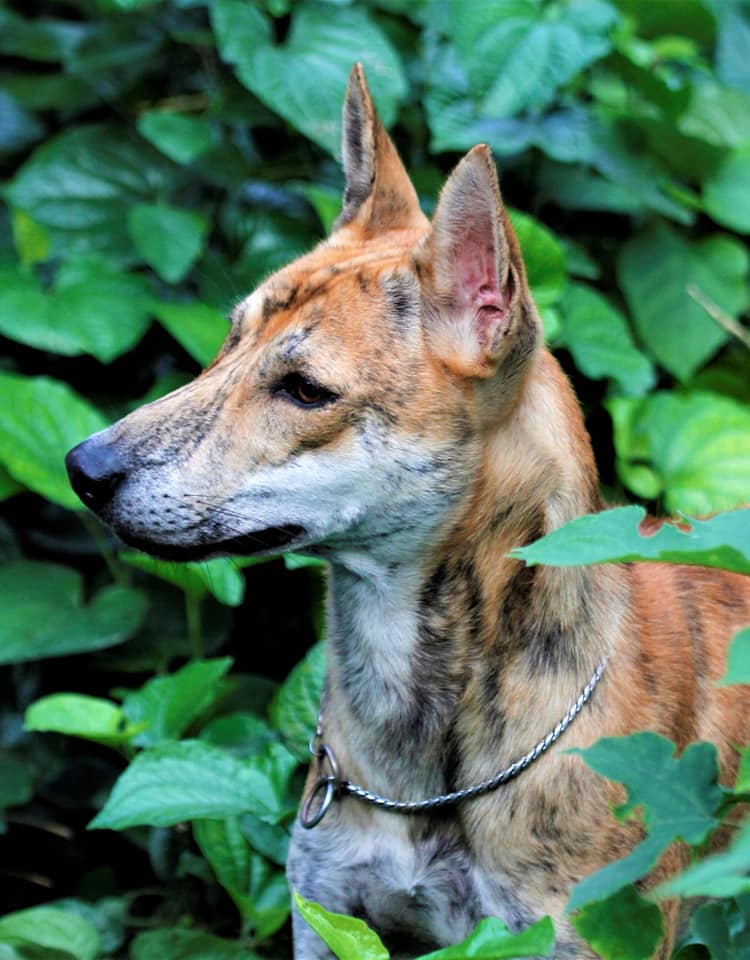
The breed is medium sized, short coated and comes in a variety of colors. Photo Red River Kennel.
“Their hunting is different from modern dogs hunting,” Hoang said, “because they’re independent thinkers, so they don’t need their hunter to actually go with them to hunt. I’ve actually watched videos of them where they’re chasing this pig …you’ve got three that are chasing this pig and then you’ve got two that have now split off to go and chase it and (corner) it on the other side. They’re thinking and communicating with themselves to go and do these roles. They’ll assign themselves roles, which is what I was told by a lot of the breeders when they do go hunt with them … that the dogs will go and do their own roles and they’ll distinguish them amongst themselves. The hunter never has to tell them what to do.
“I think a good description is just like easy going, that’s kind of like the breed characteristic is that they’re easygoing island dogs. They’ll go hunting with you all day or they’ll stay at home with you all day kind of thing. There’s so much versatility to the dogs that the people of Vietnam really, really like.”
Hoang traveled to Vietnam earlier this year and collected DNA samples from more than 100 dogs, mostly PQR but also other indigenous Vietnamese breeds, to add to the databases at Wisdom Panel and Embark.
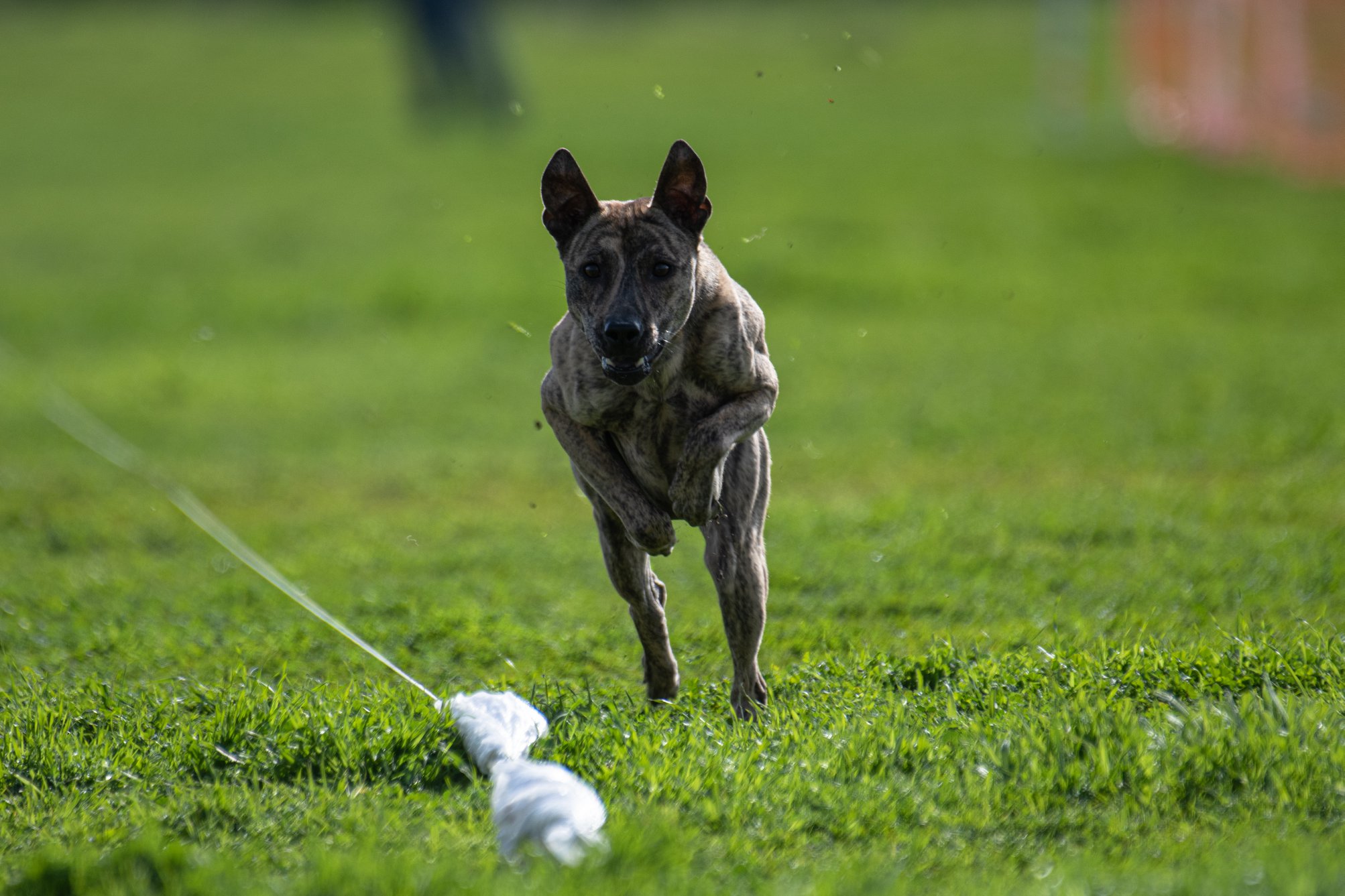
PQRA is encouraging clubs and owners to allow the breed to participate and title in various sports. Kaladin is owned by Professor Alex Gilewski.
“We’re trying to establish this breed here,” Hoang said. “Not just established it, but we’re trying to preserve what it is in Vietnam and preserve those same traits here. They’re very rare, obviously. So, it’s easy to novelize something that’s rare, something that’s new, something that’s expensive. We don’t want that. We want our breed to be loved as it is over there. We want it to be as available and accessible, but we want it to stay true to the breed that is in Vietnam.”
“We also want to make sure we’re doing it right,” Tran said. “You know that our breed that is so important to us is not just having its history recorded, but it’s also that we’re breeding for better. You know that we’re doing the health testing, that we’re making sure that breeders in Vietnam and breeders here have access to information that will help them breed better.

Hoang with her Phu Quoc Ridgebacks.
“And that’s actually one of the things that Kira did in Vietnam was as she was talking to the breeders, she’s helping give them information, like here are some of the practices that we have that can help improve your program, things that they didn’t know before.”
Learn more about this fascinating breed at https://www.pqrassociation.org/
Cover photo is Chapi courtesy of Phi Anh Kennel.


